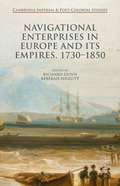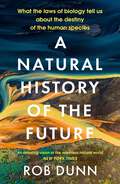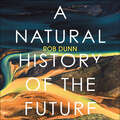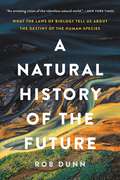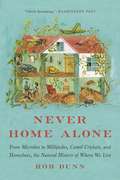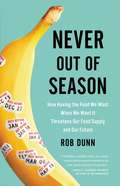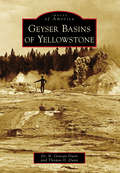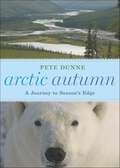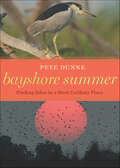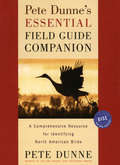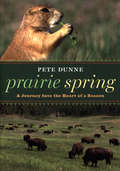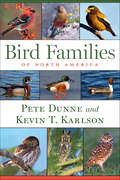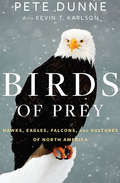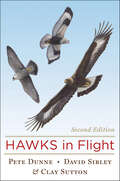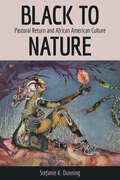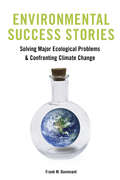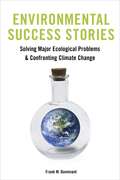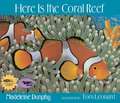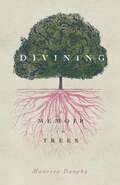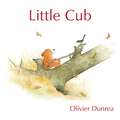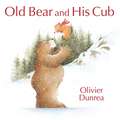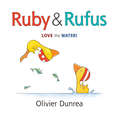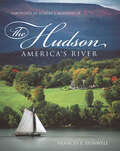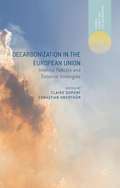- Table View
- List View
Navigational Enterprises in Europe and its Empires, 1730–1850 (Cambridge Imperial and Post-Colonial Studies)
by Richard Dunn Rebekah HiggittNavigational Enterprises in Europe and its Empires, 1730–1850.
A Natural History of the Future: What the Laws of Biology Tell Us About the Destiny of the Human Species
by Rob DunnOver the past century, our species has made unprecedented technological innovations with which we have sought to control nature. From river levees to enormous one-crop fields, we continue to try to reshape nature for our purposes - so much so it seems we may be in danger of destroying it.In A Natural History of the Future, biologist Rob Dunn argues that nothing could be further from the truth: rather than asking whether nature will survive us, better to ask whether we will survive nature. Despite our best - or worst - efforts to control the biological world, life has its own rules, and no amount of human tampering can rewrite them. Elucidating several fundamental laws of ecology, evolution, and biogeography, Dunn shows why life cannot be stopped. We sequester our crops on monocultured fields, only to find new life emerging to attack them. We dump toxic waste only to find microbes to colonize it. And even in the London Tube, we have seen a new species of mosquito emerge to take advantage of an apparently inhospitable habitat. Life will not be repressed by our best-laid plans. Instead, Dunn shows us a vision of the biological future and the challenges the next generations could face.A Natural History of the Future sets a new standard for understanding the diversity of life and our future as a species.
A Natural History of the Future: What the Laws of Biology Tell Us About the Destiny of the Human Species
by Rob DunnA leading ecologist argues that if humankind is to survive on a fragile planet, we must understand and obey its iron laws.Over the past century, our species has made unprecedented technological innovations with which we have sought to control nature. From river levees to enormous one-crop fields, we continue to try to reshape nature for our purposes - so much so it seems we may be in danger of destroying it.In A Natural History of the Future, biologist Rob Dunn argues that nothing could be further from the truth: rather than asking whether nature will survive us, better to ask whether we will survive nature. Despite our best - or worst - efforts to control the biological world, life has its own rules, and no amount of human tampering can rewrite them. Elucidating several fundamental laws of ecology, evolution, and biogeography, Dunn shows why life cannot be stopped. We sequester our crops on monocultured fields, only to find new life emerging to attack them. We dump toxic waste only to find microbes to colonize it. And even in the London Tube, we have seen a new species of mosquito emerge to take advantage of an apparently inhospitable habitat. Life will not be repressed by our best-laid plans. Instead, Dunn shows us a vision of the biological future and the challenges the next generations could face.A Natural History of the Future sets a new standard for understanding the diversity of life and our future as a species.(P) 2022 Hachette Audio
A Natural History of the Future: What the Laws of Biology Tell Us about the Destiny of the Human Species
by Rob DunnA leading ecologist argues that if humankind is to survive on a fragile planet, we must understand and obey its iron lawsOur species has amassed unprecedented knowledge of nature, which we have tried to use to seize control of life and bend the planet to our will. In A Natural History of the Future, biologist Rob Dunn argues that such efforts are futile. We may see ourselves as life&’s overlords, but we are instead at its mercy. In the evolution of antibiotic resistance, the power of natural selection to create biodiversity, and even the surprising life of the London Underground, Dunn finds laws of life that no human activity can annul. When we create artificial islands of crops, dump toxic waste, or build communities, we provide new materials for old laws to shape. Life&’s future flourishing is not in question. Ours is.As ambitious as Edward Wilson&’s Sociobiology and as timely as Elizabeth Kolbert&’s The Sixth Extinction, A Natural History of the Future sets a new standard for understanding the diversity and destiny of life itself.
Never Home Alone: From Microbes to Millipedes, Camel Crickets, and Honeybees, the Natural History of Where We Live
by Rob DunnA natural history of the wilderness in our homes, from the microbes in our showers to the crickets in our basements <P><P>Even when the floors are sparkling clean and the house seems silent, our domestic domain is wild beyond imagination. In Never Home Alone, biologist Rob Dunn introduces us to the nearly 200,000 species living with us in our own homes, from the Egyptian meal moths in our cupboards and camel crickets in our basements to the lactobacillus lounging on our kitchen counters. You are not alone. <P><P>Yet, as we obsess over sterilizing our homes and separating our spaces from nature, we are unwittingly cultivating an entirely new playground for evolution. These changes are reshaping the organisms that live with us--prompting some to become more dangerous, while undermining those species that benefit our bodies or help us keep more threatening organisms at bay. <P><P>No one who reads this engrossing, revelatory book will look at their homes in the same way again.
Never Out of Season: How Having the Food We Want When We Want It Threatens Our Food Supply and Our Future
by Rob DunnA Fast Food Nation for the foods we grow and depend onThe bananas we eat today aren't your parents' bananas: We eat a recognizable, consistent breakfast fruit that was standardized in the 1960s from dozens into one basic banana. But because of that, the banana we love is dangerously susceptible to a pathogen that might wipe them out.That's the story of our food today: Modern science has brought us produce in perpetual abundance-once-rare fruits are seemingly never out of season, and we breed and clone the hardiest, best-tasting varieties of the crops we rely on most. As a result, a smaller proportion of people on earth go hungry today than at any other moment in the last thousand years, and the streamlining of our food supply guarantees that the food we buy, from bananas to coffee to wheat, tastes the same every single time.Our corporate food system has nearly perfected the process of turning sunlight, water and nutrients into food. But our crops themselves remain susceptible to the nature's fury. And nature always wins.Authoritative, urgent, and filled with fascinating heroes and villains from around the world, Never Out of Season is the story of the crops we depend on most and the scientists racing to preserve the diversity of life, in order to save our food supply, and us.
Geyser Basins of Yellowstone
by Thomas D. Dunn Dr N. DunnYellowstone National Park contains over half the world's active geysers, with more than 700 within its 3,472 square miles. The most famous geyser is Old Faithful, named in 1870 during the Washburn-Langford-Doane Expedition. In 1871, the US Geological and Geographical Survey, led by Dr. F.V. Hayden, reached the Upper Geyser Basin. In just over a day, the explorers witnessed eruptions of many geysers still seen today, including Giantess, Beehive, Grotto, Castle, and Old Faithful. Yellowstone became the first National Park in 1872. Since then, visitors have come in increasing numbers to witness the unique geysers, numerous wildlife, and spectacular scenery.
Arctic Autumn: A Journey to Season's Edge
by Pete DunneThe Arctic doesn't spring to mind when most people think about autumn. Yet in his continuing effort to invite readers' curiosity through unpredictability, Pete Dunne pairs the transitional season of autumn with this fragile environment in flux. The book begins on Bylot Island in Nunavut, Canada, at the retreating edge of the seasonal ice sheet, then moves to Alaska, where the needs of molting geese go head to head with society's need for oil. Then on to the Barren Lands of Canada and a search for the celebrated caribou herds that mean life and death for human and animal predators alike. A canoe trip down the John River is filled with memories, laughter, and contemplation. A caribou hunt with a professional trapper leads to a polemic on hunting. Dunne travels to an island in the Bering Sea, off the coast of Alaska, to look for rare birds and ponder the passionate nature of competitive bird listers. No trip to the Arctic would be complete without a trip to see polar bears, so Dunne and his wife visit Churchill, Manitoba, the polar bear capital of the world. These majestic but threatened creatures lead Dunne to think about his own life, our interactions with the natural world, and the importance of the Arctic, North America's last great wilderness.
Bayshore Summer: Finding Eden in a Most Unlikely Place
by Pete DunneBypassed by time and &“Joisey&” Shore–bound vacationers, the marshes and forests of the Bayshore constitute one of North America&’s last great undiscovered wild places. Sixty million people live within a tank of gas of this environmentally rich and diverse place, yet most miss out on the region&’s amazing spectacles. Bayshore Summer is a bridge that links the rest of the world to this timeless land. Pete Dunne acts as ambassador and tour guide, following Bayshore residents as they haul crab traps, bale salt hay, stake out deer poachers, and pick tomatoes. He examines and appreciates this fertile land, how we live off it and how all of us connect with it. From the shorebirds that converge by the thousands to gorge themselves on crab eggs to the delicious fresh produce that earned the Garden State its nickname, from the line-dropping expectancy of party boat fishing to the waterman who lives on a first-name basis with the birds around his boat, Bayshore Summer is at once an expansive and intimate portrait of a special place, a secret Eden, and a glimpse into a world as rich as summer and enduring as a whispered promise.
Pete Dunne's Essential Field Guide Companion: A Comprehensive Resource for Identifying North American Birds
by Pete DunneFrom the award-winning birder and author of Birds of Prey, an authoritative, information-packed guide to distinguishing North American birds.In this book, bursting with more information than any field guide could hold, the well-known author and birder Pete Dunne introduces readers to the &“Cape May School of Birding.&” It's an approach to identification that gives equal or more weight to a bird's structure and shape and the observer's overall impression (often called GISS, for General Impression of Size and Shape) than to specific field marks. After determining the most likely possibilities by considering such factors as habitat and season, the birder uses characteristics such as size, shape, color, behavior, flight pattern, and vocalizations to identify a bird. The book provides an arsenal of additional hints and helpful clues to guide a birder when, even after a review of a field guide, the identification still hangs in the balance. This supplement to field guides shares the knowledge and skills that expert birders bring to identification challenges. Birding should be an enjoyable pursuit for beginners and experts alike, and Pete Dunne combines a unique playfulness with the work of identification. Readers will delight in his nicknames for birds, from the Grinning Loon and Clearly the Bathtub Duck to Bronx Petrel and Chicken Garnished with a Slice of Mango and a Dollop of Raspberry Sherbet.
Prairie Spring: A Journey Into the Heart of a Season
by Pete DunneA grasslands nature trek that &“weaves together spiritual insight, plant biology, geology lessons and American history—and a plethora of bird sightings&” (Publishers Weekly, starred review). A nature writer and avid birder offers a portrait of a season in the heartland of North America as he and his wife travel through the country and share stories of all that they encounter: people putting their lives back in place after a tornado, volunteers giving their time to conservation efforts, and the drive of all species to move their genes to the next generation, which manifests itself so abundantly in spring. &“Their journey begins in New Jersey and continues to Nebraska, their arrival timed to witness the annual migration of half a million northbound sandhill cranes. Next come Colorado and a primer on how homesteading sodbusters transformed an ocean of vibrant prairie grasses into a devastating dustbowl; New Mexico and the Sixth Annual High Plains Lesser Prairie-Chicken Festival; back through Colorado and the Pawnee National Grasslands for a glimpse of the threatened prairie dog, once (along with bison) among the environmental engineers of the 19th century Western plains; and into South Dakota, home to between 800 and 1,400 free-ranging bison. Dunne&’s melodic prose and rhapsodic connection with the natural world brilliantly entice an estranged audience to explore a . . . now alien environment.&” —Publishers Weekly, starred review &“Although a theme of humanity&’s effects on the prairie runs as an undercurrent throughout the narrative, it never overwhelms the sense of awe and wonder at the natural beauty of the grasslands and their inhabitants.&” —Booklist
Bird Families of North America
by Pete Dunne Kevin T. KarlsonFocusing on families and their shared traits makes bird identification easier than ever.This guide takes readers beyond merely identifying birds to understanding them. Many birders can tell the difference between a White-eyed and Bell&’s Vireo but cannot begin to describe a vireo and what distinguishes members of this family from warblers or flycatchers. The &“species by species&” approach makes it difficult to appreciate birds for what they are: members of well-organized groupings united by common traits. Putting the focus on families, and their shared characteristics, makes bird identification easier and more meaningful. More than 150 color photos illustrate the 81 bird families of the United States and Canada.
Birds of Prey: Hawks, Eagles, Falcons, and Vultures of North America
by Pete Dunne Kevin T. KarlsonA visually stunning, comprehensive resource on North America&’s birds of prey, from the award-winning birder and author of Gulls Simplified.Always a popular group of birds, raptors symbolize freedom and fierceness, and in Pete Dunne&’s definitive guide, these traits are portrayed in hundreds of stunning color photographs showing raptors up close, in flight, and in action—fighting, hunting, and nesting. These gorgeous photographs enhance the comprehensive, authoritative text, which goes far beyond identification to cover raptor ecology, behavior, conservation, and much more. In returning to his forte and his first love, Pete Dunne has crafted a benchmark book on raptors: the first place to turn for any question about these highly popular birds, whether it&’s what they eat, where they live, or how they behave. &“Birds of Prey is exhaustively researched and complemented by a stunning collection of photos, but the real highlight is…Dunne&’s writing. He weaves together personal anecdotes, historical accounts, and technical information to create something greater than the sum of all its parts: a beautiful, authoritative, and engagingly written guide to the natural history of North American hawks.&”—David Sibley, author of The Sibley Guide to Birds&“Books about raptors used to fall into two major categories: field guides versus nature writing. No more!...Dunne&’s new book skillfully conjoins those two genres. Life a good field guide, Birds of Prey is authoritative and utilitarian, and like our finest nature writing, Dunne&’s prose is lyrical, sensitive, and full of feeling.&”—Ted Floyd, editor, Birding
Hawks In Flight
by Pete Dunne David Sibley Clay SuttonAmong the world's most popular birds, hawks can be some of the most difficult birds to identify. They're most often seen flying high above and at a distance. In the first edition of Hawks in Flight, Pete Dunne, David Sibley, and Clay Sutton presented a holistic method of hawk identification, using general body shape, the way they move, and the places they are most likely to be seen. The new edition of the book that Roger Tory Peterson called a "landmark" integrates an array of carefully selected photographs, David Sibley's superb illustrations, and a clear, information-packed text and takes raptor identification to a higher level. This edition covers all of the raptors that breed in North America, including those with limited ranges in Florida, the Southwest, and Texas. Picking up where its predecessor ended by including two decades of raptor identification refinement, Hawks in Flight summarizes and places in users&’ hands an identification skill set that used to take years to master. The unique alchemy of Dunne, Sibley, and Sutton—including their collective experience of more than one hundred years watching hawks—make this book a singular achievement and a must-have for anyone interested in hawks.
Black to Nature: Pastoral Return and African American Culture
by Stefanie K. DunningIn Black to Nature: Pastoral Return and African American Culture, author Stefanie K. Dunning considers both popular and literary texts that range from Beyoncé’s Lemonade to Jesmyn Ward’s Salvage the Bones. These key works restage Black women in relation to nature. Dunning argues that depictions of protagonists who return to pastoral settings contest the violent and racist history that incentivized Black disavowal of the natural world. Dunning offers an original theoretical paradigm for thinking through race and nature by showing that diverse constructions of nature in these texts are deployed as a means of rescrambling the teleology of the Western progress narrative. In a series of fascinating close readings of contemporary Black texts, she reveals how a range of artists evoke nature to suggest that interbeing with nature signals a call for what Jared Sexton calls “the dream of Black Studies”—abolition. Black to Nature thus offers nuanced readings that advance an emerging body of critical and creative work at the nexus of Blackness, gender, and nature. Written in a clear, approachable, and multilayered style that aims to be as poignant as nature itself, the volume offers a unique combination of theoretical breadth, narrative beauty, and broader perspective that suggests it will be a foundational text in a new critical turn towards framing nature within a cultural studies context.
Environmental Success Stories: Solving Major Ecological Problems and Confronting Climate Change
by Frank DunnivantUnlike many titles on environmental issues that portend a dark future, Environmental Success Stories delves into the most daunting ecological and environmental challenges humankind has faced and shows how scientists, citizens, and a responsive public sector have dealt with them successfully.In addition to presenting the basic chemical and environmental science underlying problems like providing clean drinking water, removing DDT and lead from agriculture and our homes, and curtailing industrial pollution, this book also discusses the political actors, agency regulators, and community leaders who have collaborated to enact effective legislation. Sharing the stories of the people, organizations, and governments who have addressed these problems successfully, Frank M. Dunnivant explains how we might confront the world's largest and most complex environmental crisis: climate change. Now is the time for rededicated scientific exploration and enlightened citizen action to save our environment, and Dunnivant's book offers a stirring call to action.
Environmental Success Stories: Solving Major Ecological Problems And Confronting Climate Change
by Frank Dunnivant Kari Marie NorgaardUnlike many titles on environmental issues that portend a dark future, Environmental Success Stories delves into the most daunting ecological and environmental challenges humankind has faced and shows how scientists, citizens, and a responsive public sector have dealt with them successfully. <P><P> In addition to presenting the basic chemical and environmental science underlying problems like providing clean drinking water, removing DDT and lead from agriculture and our homes, and curtailing industrial pollution, this book also discusses the political actors, agency regulators, and community leaders who have collaborated to enact effective legislation. Sharing the stories of the people, organizations, and governments who have addressed these problems successfully, Frank M. Dunnivant explains how we might confront the world's largest and most complex environmental crisis: climate change. Now is the time for rededicated scientific exploration and enlightened citizen action to save our environment, and Dunnivant's book offers a stirring call to action.
Here Is The Coral Reef
by Madeleine Dunphy Tom LeonardSet in Australia's Great Barrier Reef, this lyrical rhyming tale introduces young readers to some of the coral reef's most striking residents. From the sleek shark to the colorful parrotfish to the deceptively beautiful sea anemone, each creature in this abundant undersea world relies on another for its existence. Beginning with coral, the very element that defines this ecosystem, Madeleine Dunphy uses a cumulative approach, combining simple yet forceful verse with repetition to reveal the fragile chain that links each of the plants and animals in this unique environment. Tom Leonard's vibrant paintings capture this miraculous circle of life.
Divining, A Memoir in Trees (Made in Michigan Writers Series)
by Maureen DunphyIn sixteen essays, each named after a species of tree, Maureen Dunphy explores the nature of human-arboreal relationships, and how each of these trees has—literally—served as a friend, a confidante, or a place to rest. The depth and diversity of these relationships are revealed through essays that are both intimate and universal, moving and informative. While Dunphy’s relationships with trees are unique and personal, her work reveals the deep-rooted complexity that connects all of humanity to our staunch, upright companions in life, the members of the "Standing Nation." Beyond providing oxygen, food, and shelter, trees can be sites of emotional refuge, sources of intellectual enrichment, and a boon to physical, mental, and spiritual health. With essays, such as "Stairway to Heaven: The American Sycamore" and "Rocky Mountain High: The Colorado Pinyon," Dunphy gives readers many ways to reimagine our relationships with nature and self. Within reflections of her personal experience, she skillfully integrates scientific facts to achieve a balance of passion and practicality. While technology, screens, and the stress of the modern world directs our attention elsewhere, Dunphy brings the reader back to the trees right outside our windows. Divining is printed on recycled paper.
Little Cub (Little Cub)
by Olivier DunreaA darling companion to Old Bear and His Cub from the New York Times bestselling creator of the Gossie booksWhat's an Old Bear to do when he finds a Little Cub all alone and afraid of the dark? Adopt him, of course! And help him try to get over his fears. In this book we see the father and son from Old Bear and His Cub meet for the first time--and grow to love one another.With the same bold art and humorous twist on parenting, Olivier Dunrea's tumbling bears will melt your heart and show how strong the bond is between any father and son pair.
Old Bear and His Cub (Little Cub)
by Olivier DunreaFrom the creator of the Gossie and Gertie books comes a playful and charming twist on the relationship between children and the adults who care for them.Old Bear loves Little Cub with all his heart. He makes sure that Little Cub eats all his porridge, takes a nap during their snowy walk, and wraps his red scarf tightly around his ears. Little Cub doesn't want to be told what to do, but he always listens to Old Bear because he knows that Old Bear loves him so. But when Old Bear catches a cold, it's Little Cub who knows just what to do to make Old Bear feel better. This winning story shows just how much Old Bears and Little Cubs love one another--with all their hearts.
Ruby & Rufus (Gossie & Friends)
by Olivier DunreaIn this preschool tale from the world of Gossie & Friends, water-loving goslings Ruby and Rufus play on the pond come rain, sleet, snow, or shine! Ruby and Rufus play at the pond every day. They swim in the rain. They swim when it's windy. Nothing can stop this inseparable pair from doing what they love -- until one day, the pond turns to ICE! Could it be that a frozen pond is twice as nice?Ruby & Rufus features the perfectly-pitched storytelling and adorable illustrations so beloved by fans of Olivier Dunrea's Gossie&Friends series.
The Hudson: America's River
by Frances DunwellFrances F. Dunwell presents a rich portrait of the Hudson and of the visionary people whose deep relationship with the river inspires changes in American history and culture. Lavishly illustrated with color plates of Hudson River School paintings, period engravings, and glass plate photography, The Hudson captures the spirit of the river through the eyes of its many admirers. It shows the crucial role of the Hudson in the shaping of Manhattan, the rise of the Empire State, and the trajectory of world trade and global politics, as well as the river's influence on art and architecture, engineering, and conservation.
The Hudson: America's River
by Frances F. Dunwell&“A commanding and inspiring biography of a river that gave rise to an art movement, progressive social quests, [and] landmark environmental cases.&” —Booklist (starred review) Includes maps, photos, and illustrations Frances F. Dunwell presents a rich portrait of the Hudson and of the visionary people whose deep relationship with the river inspired changes in American history and culture. Lavishly illustrated with color plates of Hudson River School paintings, period engravings, and glass plate photography, The Hudson captures the spirit of the river through the eyes of its many admirers. It reveals the crucial role of the Hudson in the shaping of Manhattan, the rise of the Empire State, and the trajectory of world trade and global politics, as well as the river&’s influence on art and architecture, engineering, and conservation. &“A story of interaction between people and the environment and a story of continuing inspiration and renewal.&” —Library Journal
Decarbonization in the European Union
by Claire Dupont Sebastian Oberth�rIn October 2009, the European Union (EU) agreed to reduce greenhouse gas (GHG) emissions by between 80 and 95 per cent by 2050 in the EU as a whole, as compared to 1990 levels – an objective that is in line with scientific calls to ensure we have a chance of limiting global temperature increase to 2#65533;Celsius. With the EU's energy sector required to almost completely decarbonise by 2050 (meaning almost zero GHG emissions from energy production, transportation and consumption), a major transition in just a few decades is necessary to achieve this goal. Therefore, a long-term policy perspective towards 2050 is essential. Many decisions taken today influence the EU's ability to meet its decarbonisation goals. The authors investigate how far the EU is along the road to decarbonisation, and what remains to be done in policy development. They also seek to understand whether the decarbonisaton goal is a central feature of the EU's external relations with its energy partners, andhow these relations could change under decarbonisation.
